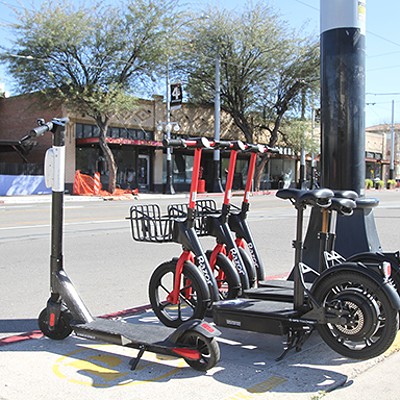The community simply can't afford to build highways. Huckelberry estimates the cost of a freeway through the urban area would likely run about $100 million a mile--10 times the cost of building your average four-lane arterial road.
So even if Tucsonans supported a freeway at the ballot box--the city's Neighborhood Protection Amendment requires a public vote before such a project could be undertaken--there's no money to build one.
That's a big disappointment for some members of Tucson's business community. Developer Bill Estes Jr., for example, thinks a freeway "is just one of many things that need to be done to improve transportation in Tucson."
Estes doesn't offer much in the way of suggestions when it comes to funding a freeway. He's also a little unsure about where to put one--that's the job of "good transportation planners"--but he suggests the county could dust off old plans to build a freeway along the Pantano and Rillito riverbeds, downplaying the environmental consequences of running a highway down the community's last major greenbelt. "It could be a greenbelt freeway and have the trees and all of that stuff alongside of it," Estes muses. "You travel around the United States and you see a lot of freeways where they've done a nice job, and I think a nice job could be done here."
But Huckelberry says that's one road that will never be built. "It's not on the table," he says. "Too many lost opportunities. It's not going to happen."
SO WHAT IS going to happen? What are the alternatives for moving cars and relieving congestion?
Those are two of the key questions facing the city's newest committee of concerned citizens, created last week by the City Council to explore Tucson's transportation options. The 15-member committee, scheduled to begin work next month, is supposed to consider all manner of funding possibilities, but it's widely expected to propose asking voters to approve a half-cent sales tax dedicated to transportation.
The tax, which would raise an estimated $40 million a year, would boost revenues for a transportation department that needs an estimated $520 million just to meet minimum standards for residential streets, sidewalks, streetlights and arterial streets. The city's five-year capital improvement budget has a mere $32 million available for these kinds of projects.
And those unhappy numbers don't include the cost of improving mass transit, which is also struggling to serve the community.
Tough choices lie ahead for the new citizens committee if it hopes to recommend a plan that will be palatable to voters, who shot down previous transportation sales tax propositions in 1986 and 1990. The committee hopes to wrap up work by November so that the council can add final touches before putting the proposition before voters next May. With such a tight timeline, it's likely the new committee will piggyback on the work of the city's existing Citizens Transportation Advisory Committee, especially since three members of the new committee will come from the existing panel.
That transportation committee recently voted in favor of a new long-range transportation policy of redefining Tucson's arterial network to create a three-tiered system of arterial streets: cross-town parkways for long trips; major arterials like today's streets; and streets devoted primarily to transit use.
Dale Calvert, chair of the committee, envisions three limited-access parkways running east-west, with another three running north-south. For the east-west corridors, Calvert suggests Grant Road, Barraza-Aviation Parkway and Valencia Road. The choices for north-south corridors vary, but Campbell Avenue, Alvernon Way and Craycroft, Wilmot and Kolb roads are each shown as six lanes on the Pima Association of Government's latest 25-year transportation plan. Houghton Road, on the city's booming southeastern corner, is another possibility.
One of those east-west corridors is already in place. With the exception of a final mile through downtown, estimated to cost $120 million, the Barraza-Aviation Parkway already offers a rapid route between downtown and the southeast side, but drivers have yet to embrace it as a cross-town freeway. Built to handle more than 40,000 cars daily, the parkway at its Broadway terminus carried only 11,500 cars last year--about the same as Tucson Boulevard through the Sam Hughes neighborhood. Still, Calvert says it can play a key role in alleviating congestion, especially once the final mile reaches Interstate 10. Unfortunately for drivers hoping for a quick connection to I-10, however, the state recently closed the St. Mary's Road exit where Aviation-Barraza may someday intersect the freeway, so drivers will only reach a frontage road.
The second option, Valencia Road, will become increasingly important as the city's south and east boundaries continue to expand to include vacant state land awaiting development. With some of the land along Valencia still undeveloped, it remains relatively cheap for the city to acquire for a future parkway. But dollars spent there with an eye on the future are dollars that can't be spent on streets currently in need of repair.
The third option, Grant Road, remains the biggest challenge. Long-range policy calls for widening Grant Road to six lanes, with three grade-separated intersections at Campbell, Swan and Craycroft helping cars speed crosstown.
Even without GSIs, the cost to widen Grant to six lanes between I-10 and Swan Road is estimated to be at least $100 million. Just the short stretch between Park Avenue and Oracle Road will cost roughly $28 million. Although the county promised to pony up $10 million for that project as part of a 1997 bond package, the cash-strapped City of Tucson will have to come up with the $18 million balance.
Then there's the cost of the three grade-separated intersections. Tony Paez, who stepped down as the city's transportation director last month, has estimated the cost per intersection between $20 million and $27 million apiece. Jim Glock, a deputy director with the transportation department, is more conservative, pricing the structures themselves at $6 million to $8 million, with the additional costs related to right-of-way and other considerations. But Glock concedes that those considerations significantly drive up the price. "The costs tend to escalate," he says.
THE GRADE-SEPARATED intersections--or "bantam intersections," as they used to be called, or "continuous-flow intersections," as supporters have recently renamed them--have long been touted as a solution to Tucson's traffic woes, at least by engineers.
The voting public, traditionally resistant to freeways, has tended to disagree. It shot down a plan for a bantam intersection at Broadway and Alvernon in the late 1970s. Ten years later, planners returned with a grade-separated intersection at Campbell and Grant as part of the Baja Plan, the 1990 transportation sales-tax hike that failed at the ballot.
After that vote, the Campbell/Grant proposal re-emerged as transportation planners met with neighbors, consultants and engineers. A nifty model of the latest proposal, which takes Grant under Campbell, is in the transportation department's downtown headquarters.
But the steep price keeps the project out of financial reach. The city is currently preparing to widen Campbell from Elm Street to Grant, with a year of construction scheduled to begin in January 2002. While they will lay the groundwork for a grade-separated intersection, transportation planners say the next step has to be taken by the council.
Glock extols the many benefits of GSIs. Most importantly, they increase "green time," as transportation professionals refer to the period drivers can move through intersections. More green time decreases the time cars spend idling, cutting down on pollution, and reduces the noise from braking and accelerating. Neighbors see fewer impatient drivers trying to find shortcuts on residential streets. And, because Tucson's grade-separated intersections will take one street underground, no unsightly overpass spoils mountain views.
Although Glock says even one GSI at Grant and Campbell would yield congestion improvements, many critics complain that the city would need a series of GSIs on Grant Road and around town for them to effectively relieve congestion, which could prove an expensive proposition.
"Unless you do a whole series of GSIs at $30 million a pop, you just move the problem one intersection over," says Steve Farley, a light-rail advocate who recently spearheaded the creation of Tucsonans for Sensible Transportation. "It's insanity. For that price, you could get an excellent light rail line."
On the other end of the political spectrum is developer Bill Estes Jr., who would rather see the money spent on freeways. "All you do is eliminate one stoplight in one direction," he complains. "You still have all the side streets, all the businesses, so people will still be slowing down." And, he adds, the intersections are "going to bankrupt all the businesses on that corner because their customers are not going to be able to get to them."
Even if the money can be found, GSIs have a tricky political aspect. Under the aforementioned Neighborhood Protection Amendment, city voters would have to approve plans for the interchanges. "If we want to do any more work at Grant and Campbell," says Glock, "we have to go out for a public vote."
Ultimately, given the city's other transportation needs, a grade-separated intersection at Campbell and Grant may not even make the list of projects funded through the new sales tax. In his report to the council earlier this summer, City Manager James Keene recommended splitting the $40 million between maintenance of existing residential streets, widening of some arterial streets and intersections, and public transit. Major road-building projects inside the city limits, he suggested, need to be put off until the state legislature tackles transportation funding somewhere down the road.
















